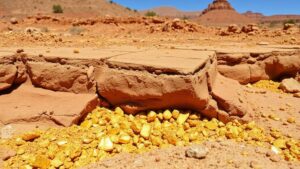The Use of Natural Caves as Early Ore Storage Locations
The Use of Natural Caves as Early Ore Storage Locations
Natural caves have played a significant role in human history, particularly in the context of mining and the storage of ores. As civilizations transitioned from nomadic lifestyles to more settled agricultural and industrial practices, the need for efficient storage methods became paramount. This article aims to explore how natural caves were utilized as early ore storage locations, examining their advantages, historical context, and examples from various regions around the world.
Historical Context
The use of caves for storage can be traced back to ancient times when early humans sought refuge, but it was during the rise of metallurgy that their potential as ore storage facilities was truly recognized. Caves offered a naturally stable environment, providing protection from the elements and potential thieves. Also, as societies began to mine minerals for tools, weapons, and ornaments, the need to safely store these materials became essential.
Advantages of Caves for Ore Storage
Natural caves present several benefits that make them suitable for ore storage:
- Climate Control: Caves maintain a relatively stable temperature and humidity level throughout the year, which can be crucial in preserving certain types of ores.
- Security: The often hidden and inaccessible entrances of caves provide natural protection against theft and vandalism.
- Accessibility: In many early mining operations, caves were located near mining sites, making it convenient to transport ores for storage.
Examples of Cave Use in Ore Storage
Several ancient cultures around the world utilized caves for storing ores. Here are a few notable examples:
- China: Archaeological findings suggest that early Chinese civilizations stored copper and lead ores in caves during the Shang dynasty (circa 1600-1046 BC). This facilitated their use in bronze production, crucial for weaponry and tools.
- Roman Empire: The Romans exploited natural caves not only for housing minerals but also as temporary storage for their extensive mining operations throughout Europe. Caves near the famous silver mines of Banska Štiavnica in present-day Slovakia served to store precious metals securely.
- Prehistoric Europe: In regions like the Carpathian Mountains, evidence shows caves were used to store flint and other minerals for toolmaking, highlighting their integral role in early human craftsmanship.
Case Study: The Caves of the Southwest USA
In the American Southwest, Native American tribes, such as the Ancestral Puebloans, used natural caves for storing ores and other valuable materials. The cave systems in regions like New Mexico provided safe havens for their pottery, tools, and minerals, thereby enhancing their storage and retrieval efficiencies.
Modern Perspectives and Lessons Learned
The historical use of natural caves as ore storage locations offers contemporary insights into sustainable practices. While modern矿 industry practices and technologies have evolved significantly, the principles of utilizing natural features for resource conservation remain relevant. Today, the emphasis on sustainability may see a resurgence in natural space utilization for materials storage, particularly with the rising awareness of environmental impact.
Conclusion
The use of natural caves as early ore storage locations reflects not only the ingenuity of ancient cultures but also their understanding of the natural environment. With inherent advantages such as climatic stability and security, caves provided an effective solution for the storage and conservation of valuable materials necessary for developing early civilizations. As we move forward, the lessons learned from these ancient practices can guide modern sustainable storage solutions.
Actionable Takeaways
- Explore the historical significance of natural storage solutions in your local area.
- Consider the environmental implications and benefits of using natural materials for storage.
- Investigate technological advancements that could merge modern storage solutions with ancient practices.



